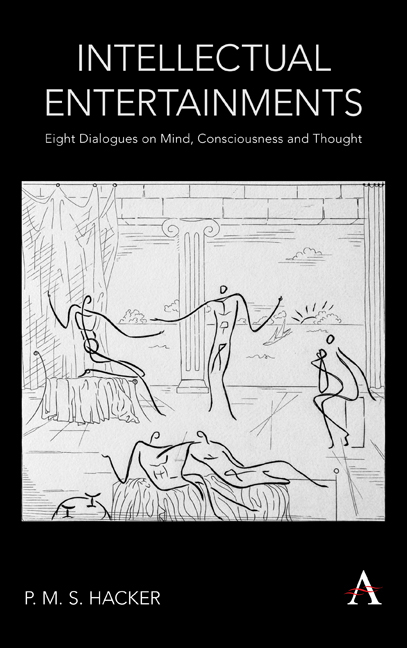Book contents
- Frontmatter
- Dedication
- Contents
- Preface
- Acknowledgements
- Section 1 Two Dialogues on Mind and Body
- Introduction
- First Dialogue On the Nature of the Mind
- Second Dialogue The Mind and the Body
- Section 2 Two Dialogues on Consciousness
- Section 3 A Dialogue on the Objectivity or Subjectivity of Perceptual Qualities
- Section 4 Two Dialogues on Thought
- Section 5 A Dialogue on Ownership of Pain
Introduction
from Section 1 - Two Dialogues on Mind and Body
Published online by Cambridge University Press: 06 December 2019
- Frontmatter
- Dedication
- Contents
- Preface
- Acknowledgements
- Section 1 Two Dialogues on Mind and Body
- Introduction
- First Dialogue On the Nature of the Mind
- Second Dialogue The Mind and the Body
- Section 2 Two Dialogues on Consciousness
- Section 3 A Dialogue on the Objectivity or Subjectivity of Perceptual Qualities
- Section 4 Two Dialogues on Thought
- Section 5 A Dialogue on Ownership of Pain
Summary
We are human beings – living animals of the species homo sapiens – with a distinctive range of abilities. We have a body; but it is far from evident that we are identical with the body we have. We have a mind; but it is equally unclear whether we are identical with the mind we have. We are also commonly said to have a soul and indeed a self. But if we have all these things, who and what are we that have them? And what exactly is it that we have? Is the soul identical with the mind or is it distinct from it? Is the divide between mind and body the same as the divide between body and soul? Sensual appetites are traditionally assigned to the body or the flesh, not to the soul. But desire is commonly assigned to the mind not to the body. And remorse and shame are commonly assigned to the soul, not to the mind. So surely the mind and the soul are distinct. I am, no doubt, myself; but am I my self? And what and where is a self? Small wonder that these questions have puzzled philosophers since the dawn of philosophy, bewildered theologians, baffled doctors and perplexed psychologists and neuroscientists.
To be sure, being living animals, we are bodies – animate spatio-temporal beings consisting of flesh and blood. But how can something that is a body also have a body? Surely one cannot have what one is? We have a mind, but what is it that human beings have when they have a mind? And how can human beings be identical with something they have? I am myself, but I surely don't have myself! A human body is a space occupant, but what is a human mind? Is it material or immaterial? Is the mind the brain? – if so, then a mind weighs three pounds and is seven inches tall! Or is the mind something immaterial? One might say, with some plausibility, that a human being is a combination of mind and body. But if that is right, then what sort of combination is involved? How can something immaterial be ‘combined’ with a body? And how can an immaterial mind or soul interact with a material body? And if they are combined, are they separable?
- Type
- Chapter
- Information
- Intellectual EntertainmentsEight Dialogues on Mind, Consciousness and Thought, pp. 3 - 6Publisher: Anthem PressPrint publication year: 2019



